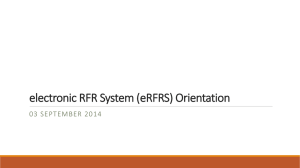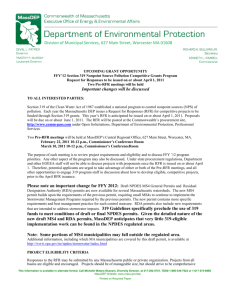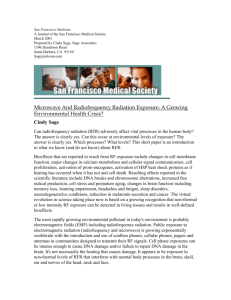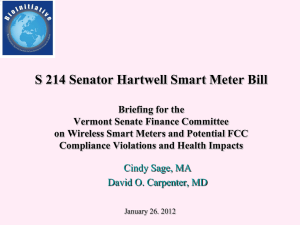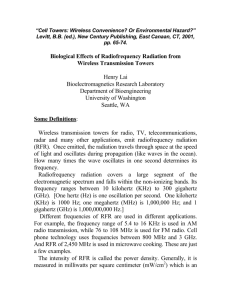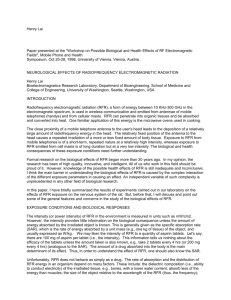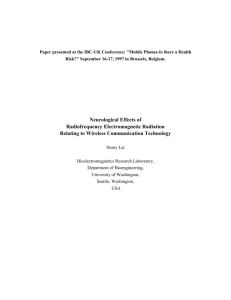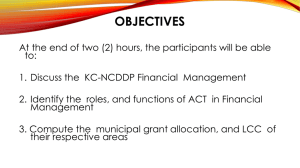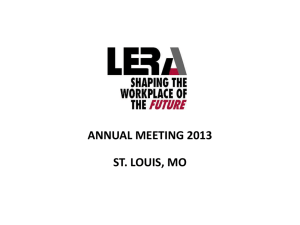Corrective Action Section Guidance for Ready for Reuse
advertisement
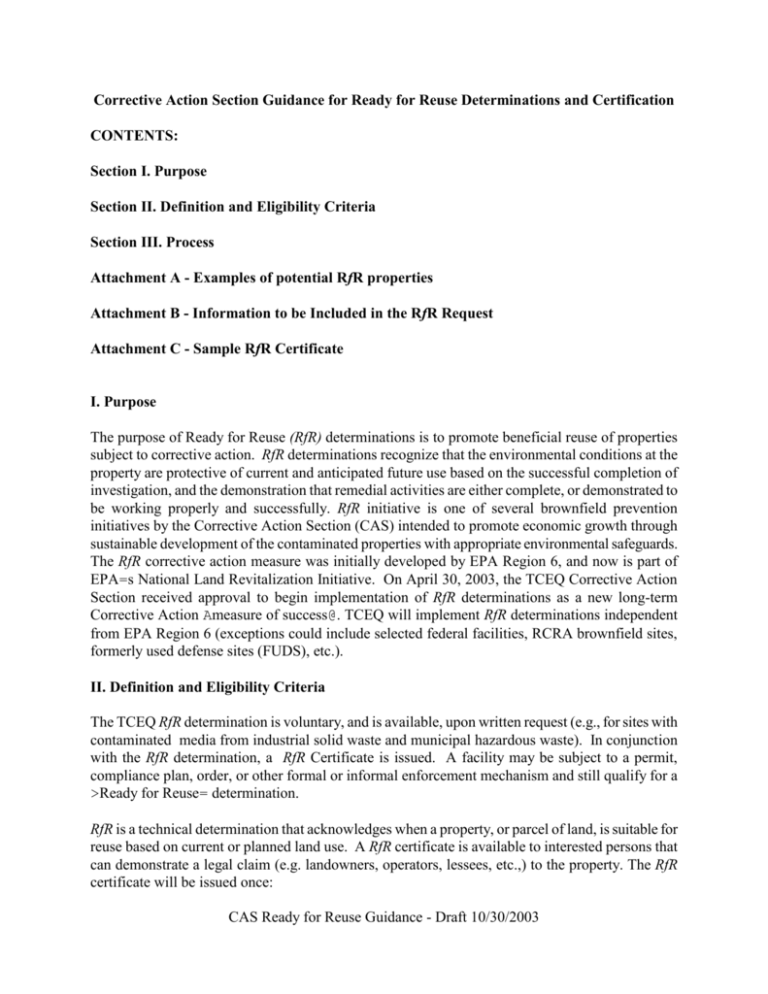
Corrective Action Section Guidance for Ready for Reuse Determinations and Certification CONTENTS: Section I. Purpose Section II. Definition and Eligibility Criteria Section III. Process Attachment A - Examples of potential RfR properties Attachment B - Information to be Included in the RfR Request Attachment C - Sample RfR Certificate I. Purpose The purpose of Ready for Reuse (RfR) determinations is to promote beneficial reuse of properties subject to corrective action. RfR determinations recognize that the environmental conditions at the property are protective of current and anticipated future use based on the successful completion of investigation, and the demonstration that remedial activities are either complete, or demonstrated to be working properly and successfully. RfR initiative is one of several brownfield prevention initiatives by the Corrective Action Section (CAS) intended to promote economic growth through sustainable development of the contaminated properties with appropriate environmental safeguards. The RfR corrective action measure was initially developed by EPA Region 6, and now is part of EPA=s National Land Revitalization Initiative. On April 30, 2003, the TCEQ Corrective Action Section received approval to begin implementation of RfR determinations as a new long-term Corrective Action Ameasure of success@. TCEQ will implement RfR determinations independent from EPA Region 6 (exceptions could include selected federal facilities, RCRA brownfield sites, formerly used defense sites (FUDS), etc.). II. Definition and Eligibility Criteria The TCEQ RfR determination is voluntary, and is available, upon written request (e.g., for sites with contaminated media from industrial solid waste and municipal hazardous waste). In conjunction with the RfR determination, a RfR Certificate is issued. A facility may be subject to a permit, compliance plan, order, or other formal or informal enforcement mechanism and still qualify for a >Ready for Reuse= determination. RfR is a technical determination that acknowledges when a property, or parcel of land, is suitable for reuse based on current or planned land use. A RfR certificate is available to interested persons that can demonstrate a legal claim (e.g. landowners, operators, lessees, etc.,) to the property. The RfR certificate will be issued once: CAS Ready for Reuse Guidance - Draft 10/30/2003 1. 2. final cleanup has been achieved, or the property has been remediated to the extent that it is protective for redevelopment based on current or planned land use. (Note: RfR determinations are not intended to be issued for parcels/sites where no release of COCs are identified, and/or analytical results for COCs in the environmental media are less than or equal to MQL/Background). RfR determinations may be issued for properties with unrestricted use (e.g., TRRP Remedy Standard A residential), or restricted use (e.g., Remedy Standard B commercial/industrial). RfR guidance is developed within the framework of existing regulations. Consequently, the RfR guidance does not impose legally binding requirements on TCEQ or the regulated community. III. Process A written request for a RfR determination should be submitted to the CAS Project Manager (PM). The request must include the following information: a. Status of remediation and how RfR is applicable to the property. Generally, TRRP (or Risk Reduction Standard, if applicable) requirements for site assessment, final remedy implementation, and institutional control (IC) (if and when applicable) must be met. Refer to TRRP Guidance Document No. 16, Institutional Controls, for applicability and timing of ICs; b. A description of current and future land use; and, c. Information included in Attachment B, including completion of the Current Environmental Conditions Table. The RfR process is not intended to require more stringent assessment activities. However, where historical information concerning the storage, release, and disposal of hazardous substances is missing or lacking, additional assessment (e.g., Phase I, and possibly Phase II) information will be needed to finalize a RfR determination. The CAS project manager will determine the adequacy of the information submitted, and make the final recommendation concerning the RfR determination. Upon approval, the agency will issue the RfR certificate. Examples of potential RfR properties are provided in Attachment A. If the CAS PM recommends issuance of a RfR certificate, the RfR determination will be documented in a letter and a RfR certificate will be issued. An example Certificate in Attachment C. In situations where the remedy standard has not been achieved (Item 4 of Attachment A) the letter would acknowledge conditional or partial completion of response actions. There are no public notice requirements during the RfR process. However, an owner/operator may seek to highlight the proposed RfR certification during fulfillment of public notice requirements of other regulations. CAS Ready for Reuse Guidance - Draft 10/30/2003 ATTACHMENT A - Examples of Potential RfR Properties 1. Property assessment analytical results for COCs are greater than the method quantitation limit (MQL)/Background and less than Tier 1 (Class 1 for ground water) assessment level applicable for residential land use. 2. Residential remedy standards have been achieved. All industrial solid waste and municipal hazardous waste and waste residues have been removed or decontaminated to residential health and ecological based standards and criteria (includes both on-site and off-site). 3. Commercial/industrial remedy standards have been achieved. All industrial solid waste and municipal hazardous waste and waste residues have been removed or decontaminated to commercial/industrial health and ecological based standards and criteria (includes both onsite and off-site). Institutional control requirements (e.g., deed notification) have been fulfilled. 4. Remedy standard not yet achieved but the property is remediated to the extent that it is protective for redevelopment based on current or planned land use. The approved remedy has been constructed and implemented, and the remedy has been demonstrated to be operating properly and successfully. No off-site contamination is associated with site. An example would be where soil cleanup is complete, the approved ground water remedial action has been implemented and shown to be operating properly and successfully. For this scenario the RfR determination would acknowledge conditional or partial completion of response actions. 5. Remedy standard achieved on-site but off-site is not yet cleaned up. Off-site contamination has been characterized and approved remedy been constructed and implemented, and the remedy has been demonstrated to be operating properly and successfully for the off-site portion. Note: The RfR is issued for on-site only property. 6. Facility parcel has both on-site and off-site contamination that requires long-term remedial action and remedy standard has not yet been attained. The approved final remedy has been constructed and implemented, and the remedy has been demonstrated to be operating properly and successfully for both the on-site and off-site areas. CAS Ready for Reuse Guidance - Draft 10/30/2003 ATTACHMENT B Information to be Included in the RfR Request A) Description of property (or parcel of property) for which RfR certificate is requested; B) Map of proposed RfR property, with latitude/longitude coordinates is available; C) Completion of the Current Environmental Conditions Table included below, listing all sites (including petroleum storage tank sites) subject to remediation and the following information for each site: 1) Remedial action taken; 2) Residual Chemicals of Concern (COCs); 3) Status (e.g. No Further Action for soil, etc.); 4) Cleanup standards for COCs; 5) Institutional control(s) [Type/Purpose/Location], (e.g., deed notice filed with Bexar County clerk to restrict use of property for commercial/industrial purposes, etc.) D) Chronology of events for each site cleanup; E) List of relevant documents (List, as Appropriate, Report Title and Date) Examples: Affected Property Assessment Reports Remedial Action Plans Remedial Action Completion Reports, RCRA Facility Assessments RCRA Facility Investigations; Corrective Measures Studies, Corrective Measure Implementation Reports Groundwater Monitoring Reports Closure Reports TCEQ approval letters, etc. CAS Ready for Reuse Guidance - Draft 10/30/2003 Current Environmental Conditionsa Table (with examples) Site Name/ Site No. East Tank Farm Area/ SWMU #14 Remedial Action Taken Residual Contaminants of Concern (COCs) Status Dig and Haul - all soils removed for offsite disposal Lead - 325 ppm Chromium VI - 25 ppm Arsenic - 5 ppm NFA for soil remediation Hydraulic containment system installed for groundwater control Lead - 100 ppm Arsenic - 2 ppm Facilities 110, 160, 706, 930, 1102, 1150, and 1189; the former UST at Bldg 606 Demolished None NFA The motor gasoline (MOGAS) tank spill in the golf course area. Soil excavation and offsite disposal Benzene - 5ppm NFA Ongoing groundwater pump and treat Cleanup Standard Institutional Control(s) (Type/Purpose /Location) In soils; Lead > 400 ppm, Chromium VI > 50 ppm, Arsenic > 25 ppm was removed. The site was closed under RRS #2.b Deed notice filed with Bexar County Clerk to restrict use of property for residential purposes.c (Specify MCL concentrations for lead, arsenic) City of Austin NO. 224, restricting installation of drinking water wells. Minimal releases. Sites considered not to have a potential for hazards from contamination. N/A (Example for Petroleum Substances:) a N/A Benzene > 50 ppm was removed Based on documents supplied by the [insert facility name]. b In order to attain RRS No. 2, all industrial solid waste and municipal hazardous waste and waste residues must be removed or decontaminated to health based standards and criteria. Contaminants allowed to remain in place in media of concern (i.e. soil, ground water, surface water, air) must not exceed the health based cleanup levels as specified in 30 TAC '335.556. c TCEQ deed certification filed pursuant to 30 TAC 335.560 in TCEQ facility files. CAS Ready for Reuse Guidance - Draft 10/30/2003 ATTACHMENT C: Sample RfR Certificate CAS Ready for Reuse Guidance - Draft 10/30/2003
